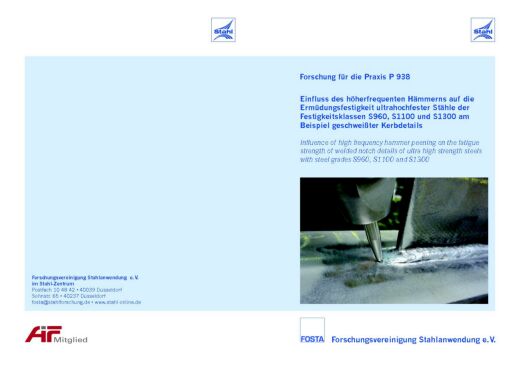Description
P 938 – Influence of high frequency hammer peening on the fatigue strength of welded notch details of ultra high strength steels with steel grades S960, S1100 and S1300
In mobile crane structures, ultra high strength fine grained structural steels (UHS) with yield strengths up to 1100 MPa and 1300 MPa respectively are used. Due to applied fatigue loads during operation, the fatigue life of welded notch details, which can be classified into the upper finite fatigue life region, is limited.
One possibility to improve the fatigue behaviour is the application of post weld treatment methods like high frequency hammer peening (HFH). HFH mainly induces compressive residual stresses in the treated weld toe area resulting in a translation and a rotation of the S-N-curve. Therefore, the S-N-curves of as welded (m ~ 3) and HFH treated (m ~ 5) notch details intersect theoretically in the upper finite fatigue life region. Existing design recommendations for the consideration of HFH are limited to maximum steel grades of S960 and plate thicknesses of 5 mm and higher. The influence of HFH-treatment on the fatigue behaviour of welded ultra high strength steels with yield strengths of 960 MPa and higher – loaded in the upper finite and low cycle fatigue life region respectively – has not been investigated sufficiently so far.
For this reason, fatigue tests have been performed at four typical welded notch details of mobile crane structures made of S960, S1100 and S1300 to determine the influence of HFH on the fatigue strength.
The fatigue strength of HFH treated specimens was at least twice the fatigue strength of the as welded toe condition. Furthermore, a fatigue life improvement due to HFH treatment can be observed at loading cycles of 10.000 and higher. The fatigue life can be improved by factors of 2 to 10 due to HFH treatment in the upper finite fatigue life region with load cycles until failure of 10,000 to 40,000 for the as welded toe condition.In some cases the location of crack initiation changes after HFH treatment from the weld toe to the weld root or to notches in the base material. The evaluation of the results showed an influence of the yield strength on the fatigue strength improvement for the notch details longitudinal stiffener and butt weld. Different plate thicknesses and weld geometries influence the comparability of test results within the evaluation based on the nominal stress concept.
The classification of the test results for the HFHtreated toe condition shows that FAT classes of existing design proposals are conservative. For the notch details of welded cover plate and butt weld with transition in thickness a further improvement of the proposed FAT classes are possible.
Further investigations are necessary to prove the influence of HFH treatment at welded ultra high strength fine grained structural steels at variable amplitude loading and increased stress ratios considering overloads and preloads.
The research project P 938 of Research Association for Steel Application was carried out at Institut für Metall- und Leichtbau der Universität Duisburg-Essen. FOSTA has accompanied and funded the research work.
Only available in german language.
Published in:
2015
Authors:
N. Stranghöner, J. Berg




